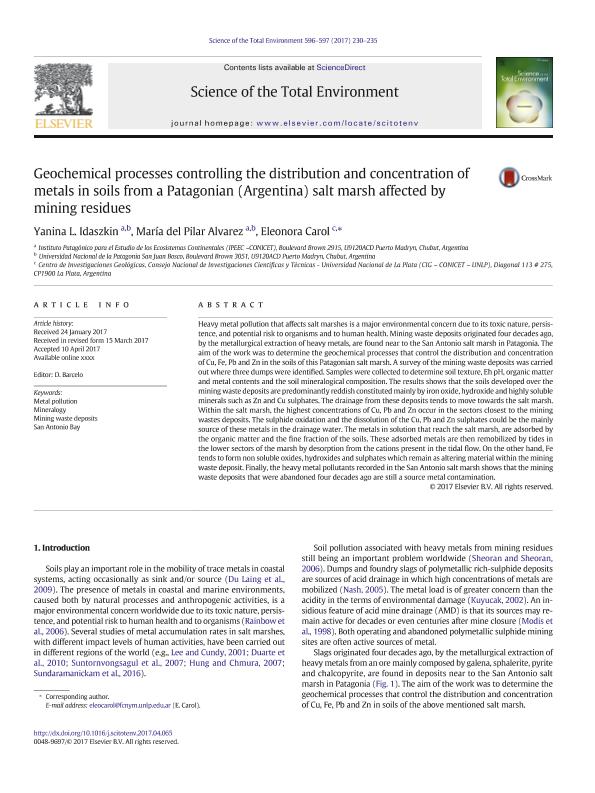Mostrar el registro sencillo del ítem
dc.contributor.author
Idaszkin, Yanina Lorena

dc.contributor.author
Alvarez, Maria del Pilar

dc.contributor.author
Carol, Eleonora Silvina

dc.date.available
2018-06-19T14:03:04Z
dc.date.issued
2017-10
dc.identifier.citation
Idaszkin, Yanina Lorena; Alvarez, Maria del Pilar; Carol, Eleonora Silvina; Geochemical processes controlling the distribution and concentration of metals in soils from a Patagonian (Argentina) salt marsh affected by mining residues; Elsevier Science; Science of the Total Environment; 596-597; 10-2017; 230-235
dc.identifier.issn
0048-9697
dc.identifier.uri
http://hdl.handle.net/11336/49216
dc.description.abstract
Heavy metal pollution that affects salt marshes is a major environmental concern due to its toxic nature, persistence, and potential risk to organisms and to human health. Mining waste deposits originated four decades ago, by the metallurgical extraction of heavy metals, are found near to the San Antonio salt marsh in Patagonia. The aim of the work was to determine the geochemical processes that control the distribution and concentration of Cu, Fe, Pb and Zn in the soils of this Patagonian salt marsh. A survey of the mining waste deposits was carried out where three dumps were identified. Samples were collected to determine soil texture, Eh pH, organic matter and metal contents and the soil mineralogical composition. The results shows that the soils developed over the mining waste deposits are predominantly reddish constituted mainly by iron oxide, hydroxide and highly soluble minerals such as Zn and Cu sulphates. The drainage from these deposits tends to move towards the salt marsh. Within the salt marsh, the highest concentrations of Cu, Pb and Zn occur in the sectors closest to the mining wastes deposits. The sulphide oxidation and the dissolution of the Cu, Pb and Zn sulphates could be the mainly source of these metals in the drainage water. The metals in solution that reach the salt marsh, are adsorbed by the organic matter and the fine fraction of the soils. These adsorbed metals are then remobilized by tides in the lower sectors of the marsh by desorption from the cations present in the tidal flow. On the other hand, Fe tends to form non soluble oxides, hydroxides and sulphates which remain as altering material within the mining waste deposit. Finally, the heavy metal pollutants recorded in the San Antonio salt marsh shows that the mining waste deposits that were abandoned four decades ago are still a source metal contamination.
dc.format
application/pdf
dc.language.iso
eng
dc.publisher
Elsevier Science

dc.rights
info:eu-repo/semantics/openAccess
dc.rights.uri
https://creativecommons.org/licenses/by-nc-sa/2.5/ar/
dc.subject
Metal Pollution
dc.subject
Mineralogy
dc.subject
Mining Waste Deposits
dc.subject
San Antonio Bay
dc.subject.classification
Meteorología y Ciencias Atmosféricas

dc.subject.classification
Ciencias de la Tierra y relacionadas con el Medio Ambiente

dc.subject.classification
CIENCIAS NATURALES Y EXACTAS

dc.title
Geochemical processes controlling the distribution and concentration of metals in soils from a Patagonian (Argentina) salt marsh affected by mining residues
dc.type
info:eu-repo/semantics/article
dc.type
info:ar-repo/semantics/artículo
dc.type
info:eu-repo/semantics/publishedVersion
dc.date.updated
2018-06-18T21:20:59Z
dc.journal.volume
596-597
dc.journal.pagination
230-235
dc.journal.pais
Países Bajos

dc.journal.ciudad
Amsterdam
dc.description.fil
Fil: Idaszkin, Yanina Lorena. Consejo Nacional de Investigaciones Científicas y Técnicas. Centro Científico Tecnológico Conicet - Centro Nacional Patagónico. Instituto Patagónico para el Estudio de los Ecosistemas Continentales; Argentina. Universidad Nacional de la Patagonia; Argentina
dc.description.fil
Fil: Alvarez, Maria del Pilar. Consejo Nacional de Investigaciones Científicas y Técnicas. Centro Científico Tecnológico Conicet - Centro Nacional Patagónico. Instituto Patagónico para el Estudio de los Ecosistemas Continentales; Argentina. Universidad Nacional de la Patagonia; Argentina
dc.description.fil
Fil: Carol, Eleonora Silvina. Consejo Nacional de Investigaciones Científicas y Técnicas. Centro Científico Tecnológico Conicet - La Plata. Centro de Investigaciones Geológicas. Universidad Nacional de La Plata. Facultad de Ciencias Naturales y Museo. Centro de Investigaciones Geológicas; Argentina
dc.journal.title
Science of the Total Environment

dc.relation.alternativeid
info:eu-repo/semantics/altIdentifier/doi/https://dx.doi.org/10.1016/j.scitotenv.2017.04.065
dc.relation.alternativeid
info:eu-repo/semantics/altIdentifier/url/https://www.sciencedirect.com/science/article/pii/S0048969717309014
Archivos asociados
